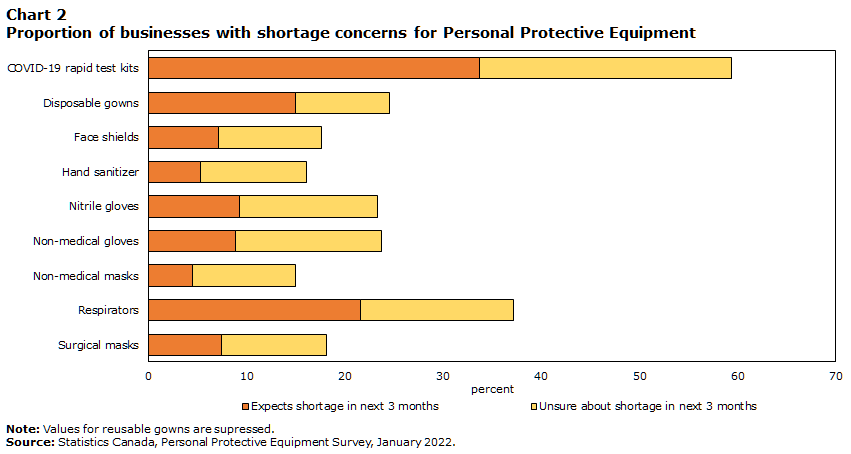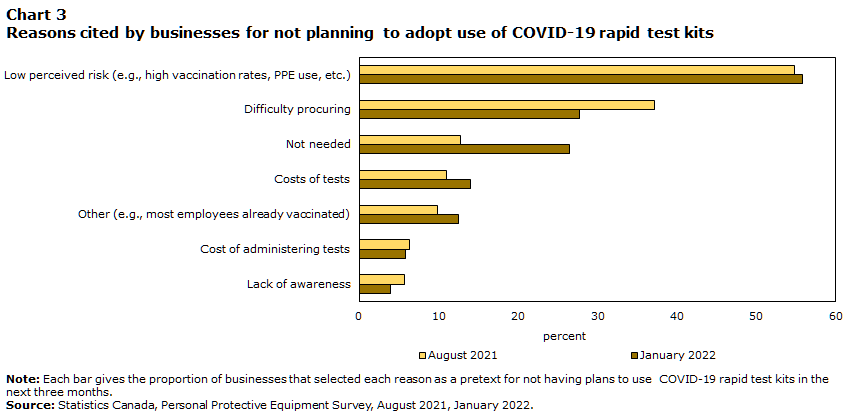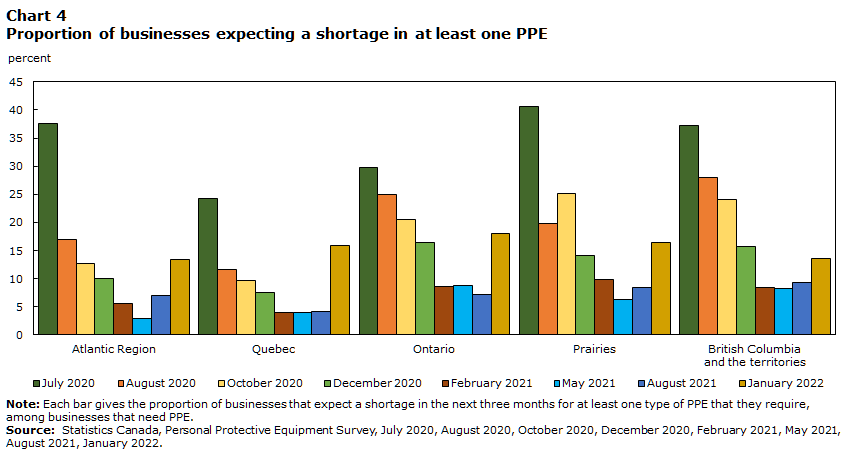 StatCan COVID-19: Data to Insights for a Better Canada
StatCan COVID-19: Data to Insights for a Better Canada
Examining businesses’ needs for personal protective equipment
Archived Content
Information identified as archived is provided for reference, research or recordkeeping purposes. It is not subject to the Government of Canada Web Standards and has not been altered or updated since it was archived. Please "contact us" to request a format other than those available.
Text begins
More than two years into the COVID-19 pandemic, there is still global demand for personal protective equipment (PPE). The emergence of new COVID-19 variants, continuation of public health guidelines, and the evolving rates of vaccination among Canadians influence the demand for PPE and bring uncertainties in the supplies and inventories of PPE.
The onset of the Omicron variant of COVID-19 in the latter part of 2021 prompted provincial governments across the country to tighten public health guidelines, which continued through the first few months of 2022, so as to limit the spread of the virus. Complementing the public health restrictions are sturdy vaccination rates, which by February 27, 2022, indicated that more than 80% of the Canadian population was fully vaccinated (Public Health Agency of Canada, 2022). Since July 2020, the Personal Protective Equipment Survey (PPES) has provided a portrait of demand and supply of PPE in Canada. This article explores the evolution of private sector businesses’ demand and supply of PPE using data from the January 2022 PPES.
Demand for PPE among businesses that needed or expected to need PPE declined in January 2022. Compared to August 2021, significantly more businesses reported having concerns about shortages of essential PPE in January 2022. Most shortage expectations were reported by businesses in the educational sector. Among the required PPE, businesses indicated an increased need for surgical masks, respirators, and COVID-19 rapid test kits in January 2022 compared to August 2021.
Businesses need for Personal Protective Equipment declines in January
Over half (55.7%) of the businesses operating in the provinces and territories reported that they needed, or expected to need PPE to operate in accordance with COVID-19 related public health guidance. This represents a 4.8 percentage point decrease in businesses demand for PPE from August 2021 and is the lowest recorded level of demand for PPE among businesses since the first iteration of the PPES in July 2020.
Different sectors of the economy continue to have varying demands for essential PPE. This has been a constant theme across all the PPES iterations. Businesses in the educational services (91.8%), health care and social assistance (77.8%), accommodation and food services (76.7%), and manufacturing (68.0%) continue to have the highest demand for PPE as opposed to businesses in professional, scientific and technical services (38.9%), finance and insurance (32.5%), and agriculture, forestry, fishing and hunting (28.4%).
Nearly two-thirds (64.1%) of the businesses that needed PPE in order to operate safely, required at least 3 of the 10 types of PPE that are covered in this survey.Note Note Similar to the previous iterations of the PPES, items of PPE that are related to sanitizing surfaces, as well as face and hand coverings are the most demanded by businesses. Consequently, the distribution of PPE items demanded has stayed relatively stable as businesses continue to cement cleaning practices in order to operate in accordance with the public health guidelines aimed at curbing the spread of COVID-19.
However, in January 2022, there has been an uptick in the demand for surgical masks, respirators, and COVID-19 rapid test kits – see chart 1.

Data table for Chart 1
| Product | January 2022 | August 2021 |
|---|---|---|
| percent | ||
| Hand sanitizer | 87.7 | 90.1 |
| Non-medical masks | 51.0 | 53.8 |
| Surgical masks | 48.3 | 39.6 |
| Non-medical gloves | 36.5 | 37.8 |
| Nitrile gloves | 32.5 | 36.0 |
| Face shields | 17.9 | 19.7 |
| Respirators | 23.0 | 11.5 |
| COVID-19 rapid test kits | 29.8 | 8.3 |
| Disposable gowns | 8.4 | 7.1 |
| Reusable gowns | 6.8 | 7.0 |
|
Note: Each bar gives the proportion of PPE most demanded by businesses. Source: Statistics Canada, Personal Protective Equipment Survey, August 2021, January 2022. |
||
Concerns about personal protective equipment shortages by businesses increase in January
Over one-third (34.2%) of the businesses that needed at least one type of PPE to operate in accordance with the public health guidelines in January 2022 indicated that they were expecting shortages in at least one type of PPE in the next three months.Note This represents an 11.1 percentage point increase in the number of businesses with shortage concerns in PPE from August 2021. This also marked the second consecutive increase in shortage concerns among businesses for which PPE was essential.
Among the businesses that had concerns of PPE shortages, those in the educational services sector were more likely (43.3%) to have shortage concerns in any one type of PPE that they require than businesses in retail (9.7%). This is consistent with the results from August 2021. Also, similar to the results from August 2021, businesses were more likely to expect or be unsure about shortages in COVID-19 rapid test kits (59.4%) than non-medical masks (15.0%) – see chart 2.

Data table for Chart 2
| Product | Expects shortage in next 3 months | Unsure about shortage in next 3 months |
|---|---|---|
| percent | ||
| COVID-19 rapid test kits | 33.7 | 25.7 |
| Disposable gowns | 15.0 | 9.5 |
| Face shields | 7.1 | 10.5 |
| Hand sanitizer | 5.3 | 10.8 |
| Nitrile gloves | 9.3 | 14.0 |
| Non-medical gloves | 8.9 | 14.8 |
| Non-medical masks | 4.5 | 10.5 |
| Respirators | 21.6 | 15.6 |
| Surgical masks | 7.4 | 10.7 |
|
Note: Values for reusable gowns are supressed. Source: Statistics Canada, Personal Protective Equipment Survey, January 2022. |
||
Most businesses not using COVID-19 rapid tests
The January 2022 PPES results show that close to two-thirds (66.4%) of businesses did not use COVID-19 Rapid Test kits to test their on-site employees for COVID-19 infection. However, there has been a significant increase in those that do. In January 2022, a quarter of the businesses (25.8%) indicated having used COVID-19 Rapid Test kits to test on-site employees, which represents a 21.3 percentage point increase in COVID-19 rapid tests usage by businesses compared to August 2021.Note
While there has been an increase in the number of businesses that have adopted the use of COVID-19 rapid test kits, more than two-fifths (44.8%) of the businesses that indicated not using rapid test kits so far still do not plan to use COVID-19 Rapid tests to check for COVID-19 infections among their on-site employees in the next three months. Businesses indicated several reasons for not adopting COVID-19 Rapid test kits in the next three months. The distribution of these reasons in January 2022 has remained fairly similar to that of August 2021. Low perceived risk (55.8%) remains the leading cause for non-adoption followed by difficulty in procuring (27.7%) and not needed (26.5%)—see chart 3.

Data table for Chart 3
| Reason | January 2022 | August 2021 |
|---|---|---|
| percent | ||
| Low perceived risk (e.g., high vaccination rates, PPE use, etc.) | 55.8 | 54.8 |
| Difficulty procuring | 27.7 | 37.1 |
| Not needed | 26.5 | 12.7 |
| Costs of tests | 14.0 | 10.9 |
| Other (e.g., most employees already vaccinated) | 12.5 | 9.8 |
| Cost of administering tests | 5.8 | 6.3 |
| Lack of awareness | 3.9 | 5.6 |
|
Note: Each bar gives the proportion of businesses that selected each reason as a pretext for not having plans to use COVID-19 rapid test kits in the next three months. Source: Statistics Canada, Personal Protective Equipment Survey, August 2021, January 2022. |
||
Shortage expectations for Personal Protective Equipment vary across the provinces
Across the provinces and territories, the proportion of businesses expecting a shortage within the next three months in at least one type of PPE which are essential to their businesses’ operation has generally been steadily declining since the first iteration of the PPES in July 2020. Beginning in August 2021 shortage concerns for at least one type of essential PPE increased for the first time in all provinces except Ontario. This January, for the second consecutive time, more businesses indicated being concerned about potential shortages in at least one type of PPE which they require in the next three months, with businesses in Ontario (18.0%) being more likely to have PPE shortage concerns than any other province—see chart 4.

Data table for Chart 4
| Region | July 2020 | August 2020 | October 2020 | December 2020 | February 2021 | May 2021 | August 2021 | January 2022 |
|---|---|---|---|---|---|---|---|---|
| percent | ||||||||
| Atlantic Region | 37.5 | 17.0 | 12.7 | 10.1 | 5.6 | 2.9 | 7.0 | 13.5 |
| Quebec | 24.3 | 11.7 | 9.7 | 7.6 | 4.0 | 4.0 | 4.2 | 15.9 |
| Ontario | 29.7 | 24.9 | 20.5 | 16.5 | 8.6 | 8.8 | 7.2 | 18.0 |
| Prairies | 40.6 | 19.9 | 25.1 | 14.1 | 9.8 | 6.3 | 8.4 | 16.5 |
| British Columbia and the territories |
37.2 | 28.0 | 24 | 15.7 | 8.5 | 8.3 | 9.3 | 13.6 |
|
Note: Each bar gives the proportion of businesses that expect a shortage in the next three months for at least one type of PPE that they require, among businesses that need PPE. Source: Statistics Canada, Personal Protective Equipment Survey, July 2020, August 2020, October 2020, December 2020, February 2021, May 2021, August 2021, January 2022. |
||||||||
Share of businesses involved in the manufacturing of personal protective equipment increases
In January 2022, nearly 1 in 10 (8.6%) of the businesses in the manufacturing, retail trade, and wholesale trade sectors were involved in the manufacturing or distribution of personal protective equipment, a 3.2 percentage point increase compared to August 2021.
The majority of the PPE that is used by businesses is acquired from domestic retailers. In total, nearly three-fifths (57.4%) of businesses reported sourcing PPE from domestic retailers. These are followed by domestic wholesalers at just over a third (34.7%), and then by domestic producers (20.8%).Note Together, more than four-fifths (83.4%) of businesses indicated using PPE from domestic sources (domestic retailers, domestic wholesalers, and domestic producers).
Data sources
Data for this analysis come from the PPES for January 2022. This voluntary survey aims to collect information on private-sector businesses’ supply, demand, use, and inventories of PPE. Along with the results of this analysis, these data are used to help the federal government model usage and inventories of PPE in Canada, and forecast potential shortfalls in these items. Results from the January iteration were based on responses from 5,219 businesses operating in Canada.
References
Public Health Agency of Canada. 2022. “Canadian COVID-19 vaccination coverage report. Ottawa: Public Health Agency of Canada.” Retrieved from https://health-infobase.canada.ca/covid-19/vaccination-coverage/
- Date modified:
